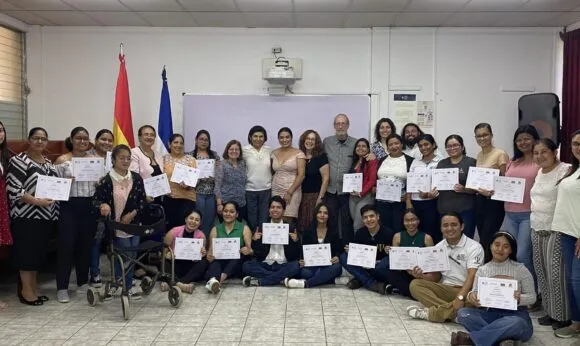
The Catalyst Center
National Center for Health Insurance and Financing for Children and Youth with Special Health Care Needs
Promote universal, continuous, and affordable coverage for all children and youth with special health care needs; close benefit and financing gaps; promote payment for additional services; and build sustainable capacity to promote financing of care.
- Impact Areas:
- Health & Mental Well-being
- Public Health & Safety
Impact
The Catalyst Center works to achieve the following objectives:
- Provide support and technical assistance to state Title V programs and their partners to help children and youth with special health care needs (CYSHCN) maximize access to health insurance and other relevant services as provided under the Affordable Care Act (ACA) and to other innovations in healthcare reform and the financing of healthcare delivery.
- Engage federal, state, and community stakeholders and partners in ensuring that implementation of the ACA and other healthcare delivery financing efforts address the needs of CYSHCN.
- Support efforts to improve coordination between Title V, Medicaid, and the Children’s Health Insurance Program (CHIP), especially related to care coordination, Early, and Periodic Screening, Diagnosis and Treatment (EPSDT) coverage, enrollment, and quality improvement.
- Identify and support policy and program initiatives at the state and federal level to reduce disparities in health insurance coverage and other healthcare financing among underserved CYSHCN, including Hispanic and African American children, older children, and those with the most significant functional limitations.
- Monitor, analyze and report on emerging federal and state trends, legislation, regulations and other relevant policy proposals related to health insurance and other health care financing.
- Identify and support innovative financing strategies to improve reimbursement for services used by CYSHCN.
- Promote strategies and policies to finance additional services, which generally are not covered by private and/or public insurance.
- Monitor progress in achieving the health insurance core outcomes and document the Catalyst Center’s impact on improving access to adequate health insurance.
Glossary
The glossary clarifies terms and concepts presented on this website. We recognize that a brief definition may not be enough for someone who is new to health care financing.
State Data Chartbook
The State Data Chartbook is a selective list of health indicators for all 50 states, Puerto Rico, and the District of Columbia. Drawing from a range of trusted sources and updated regularly, it provides data in areas including demographics, economics, child health services, insurance availability, and factors impacting coverage for children and youth with special health care needs (CYSHCN). This information can be compared state-by-state or against the national average.
Catalyst Center Project Resources
Health Care Transformation Resources
The Catalyst Center team has produced a range of peer-reviewed articles, fact sheets, reports, and other publications that demystify the complexities of the ACA, and illustrate how it impacts CYSHCN and their families.
COVID-19 Resources Archive
Many Title V and Medicaid programs use funds from their own programs or leverage other funding to reduce the number of CYSHCN without health insurance, close benefit gaps, pay for additional services, and build the capacity of the system of care.
The example strategies for improving and financing care for CYSHCN linked on this page were collected through interviews with program directors and family-to-family organization leaders in this field. In 2019 and 2020, directors and family organization leaders from all 50 states and Puerto Rico who specialize in CYSHCN were invited to participate in interviews with Catalyst Center staff. Representatives from 28 CYSHCN programs and 25 family-to-family organizations responded. Interview transcripts were approved by the interviewees, then reviewed to identify strategies, which are summarized below. For states unable to participate in interviews, Catalyst Center staff conducted keyword searches of the 2019/2021 Title V Block Grant applications to identify strategies. Strategies have been vetted with state Title V CYSHCN. program representatives for accuracy.
| Alternative Payment Models Alternative payment models (APMs) are payment approaches that aim to incentivize the delivery of high-quality and cost-effective care by linking financial incentives to quality measures. | Behavioral Health Behavioral health programs are those services and supports that address the mental, behavioral, emotional, and substance use needs of CYSHCN. | Benefits and Coverage Counseling Some Title V programs and family leader organizations provide benefits counseling to help families understand the full range of health insurance benefits and any additional coverage options available in their state. |
| Care Coordination Care coordination helps ensure children receive all needed services and avoids duplication. At its best, care coordination is a covered service. | CHIP The Children’s Health Insurance Program (CHIP) is a public benefits program exclusively for uninsured children whose family income is too high for Medicaid. | Data Collection and Analysis Collecting and analyzing data about children and youth with special health care needs populations allows Title V programs to understand population needs and tailor services accordingly. |
| Dental and Vision Services Access to needed dental and vision services, including preventative dental care, is an essential part of a well-functioning system of care for CYSHCN. | Enrollment Facilitating enrollment support, either directly or through partnerships with other organizations, can increase families’ ability to access health care services and reduce out-of-pocket costs. | EPSDT Early, and Periodic Screening, Diagnosis, and Treatment (EPSDT) is a federally mandated benefit for all children 0 to 21 enrolled in Medicaid. |
| Equity Race, ethnicity, language spoken at home, culture, number of functional difficulties, and socioeconomic factors affect access to health care and coverage for CYSHCN. | Family Supports Title V programs, Medicaid agencies, and family leader organizations offer a variety of programs that help families raising CYSHCN understand healthcare financing. | Foster Care Children and youth in foster care are an often overlooked sub-population of CYSHCN, who often have unmet health care needs. |
| Gap-Filling Services Title V gap-filling programs contribute to meeting families’ unmet needs with the aim of reducing family financial hardship and improving the health of CYSHCN. | Mandated Benefits Mandated benefits address underinsurance by requiring private health insurers to cover specific benefits, such as such as early intervention, autism services, or medical foods. | Medicaid Managed Care Many states contract with private health insurers to manage, provide or arrange for the provision of care, and coordinate care for Medicaid enrollees. |
| Medicaid Waivers States may request a waiver from the Centers for Medicare and Medicaid Services to cover other groups of individuals by “waiving” certain federal regulations. | Premium Assistance In premium assistance programs, a state agency pays all or part of a family’s health insurance premiums. These programs are often implemented for low-income working families. | Provider Adequacy Even when CYSHCN have health insurance, they may face difficulties accessing healthcare services due to narrow provider networks. |
| TEFRA The Tax Equity and Fiscal Responsibility Act (TEFRA) gives states the option to provide Medicaid coverage to children with severe disabilities who require an institutional level of care, regardless of family income. | Telehealth Telehealth is a capacity-building service that is of particular benefit in geographic areas where pediatric sub-specialty care is unavailable or difficult to access. | Title V-Medicaid Partnerships Interagency coordination is a statutory requirement for both state Title V and Medicaid programs. |
| Transition Services Transition services are the services and supports that help youth with special health care needs move from pediatric to adult systems of care. | Underinsurance State Title V agencies are often interested in reducing underinsurance for CYSHCN to improve health outcomes, increase access to care, and reduce family financial hardship. |
The National Network for Advancing Systems of Services for Children and Youth with Special Health Care Needs (CYSHCN)
About the Network
Collaborating with the Maternal and Child Health Bureau, the Network’s goal is to improve the health and well-being of CYSHCN and their families by establishing a network of centers that focus on three core health system components:
- Access to the patient/family-centered medical home, transition into adult health care systems, and adoption of health care financing models that improve care and outcomes while achieving cost savings, is the focus of the Catalyst Center.
- The Network, the Catalyst Center, the National Resource Center for Patient/Family-Centered Medical Home (NRC-PFCMH), and Got Transition collaborate to support state Title V programs, family leadership organizations, healthcare providers, and other stakeholders.
- In addition to the activities of the Network, each national center continues to provide its own technical assistance and training on topics specific to its area of expertise. The Network strives to provide a “no wrong door” approach to meeting the technical assistance needs of our stakeholders.
Options for Financing Care Coordination for Children and Youth with Special Health Care Needs
The Lucile Packard Foundation for Children’s Health Care Coordination Project gathered information from a literature review and stakeholder and state Title V staff interviews to identify options for financing and reimbursement of care coordination services for families of children and youth with special health care needs.
Care coordination financing and reimbursement can be impeded by a range of barriers, such as poorly structured payment mechanisms, low reimbursement rates, insufficient incentives to pay for care coordination, lack of clarity about who is responsible for providing and paying for care coordination, and overall limits on funding for services for children and youth with special health care needs, among others. We identify options for financing and reimbursement of care coordination services that overcome these barriers and promote payment for care coordination. We make recommendations for adopting these options, drawing on a robust array of stakeholder perspectives, including those of clinicians, payers, policymakers, families, and others. With specific guidance about options for sustaining care coordination and broad dissemination of these findings, we provide stakeholders with the information they need to adopt proven care coordination strategies that will benefit the health and well-being of children and youth with special health care needs and their families, and improve the overall system of care.
Project Impact
We identify concrete strategies to fund care coordination, a service needed by about half of families of children and youth with special health needs, but is not available due to financing and reimbursement barriers.
This project was funded by the Lucile Packard Foundation for Children’s Health.
Key Partners
Convergent partnerships are at the heart of what we do. We are proud to partner with federal and state agencies, non-profit and advocacy organizations, philanthropic institutions, and universities to elevate social work leadership and to create equitable health and mental health care systems for all.







